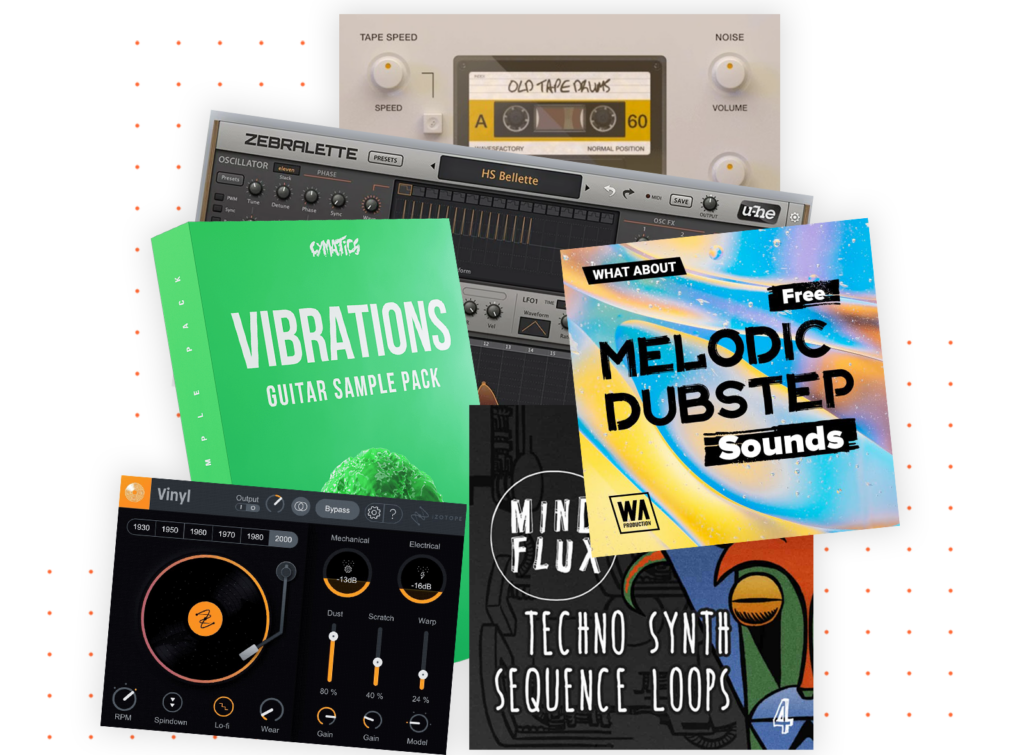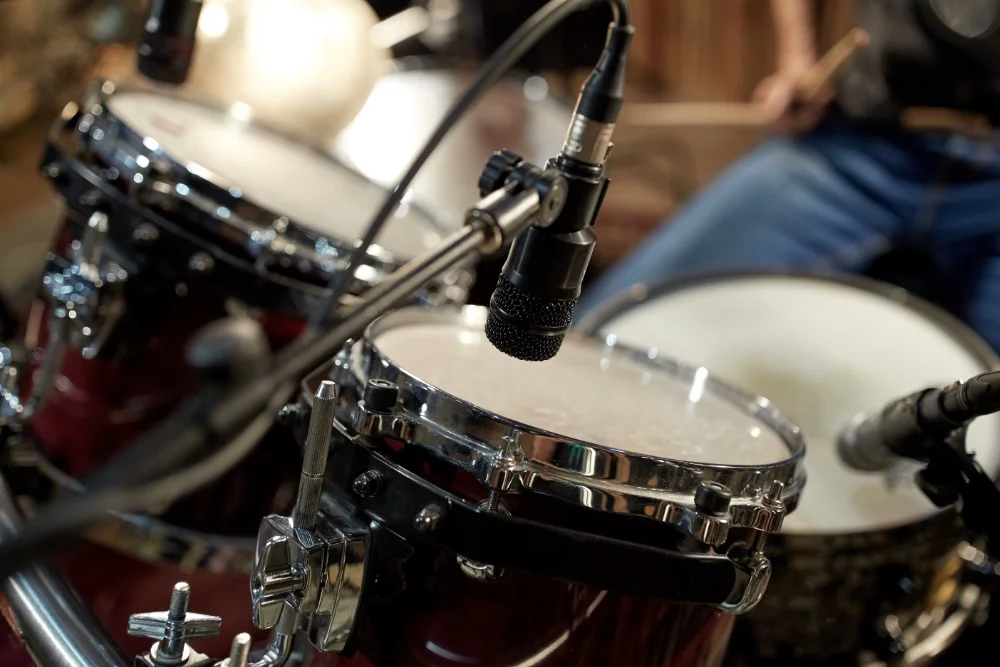Overhead microphones play a crucial role in capturing the overall sound of a drum kit.
They pick up the cymbals, the toms, and the general ambience of the kit, providing a cohesive and balanced representation of the drummer’s performance.
However, to truly optimize the sound of the overheads, proper EQ technique is essential.
EQ, or equalization, allows you to shape the frequency balance of the overhead mics, taming problematic areas and enhancing desirable characteristics to achieve the perfect drum sound for your recording.
Overhead Mic Placement
Before diving into EQ, it’s important to start with optimal overhead mic placement.
There are several common techniques, such as the spaced pair, XY, and ORTF configurations, each offering a different stereo image and tonal balance.
Experiment with different placements to find what works best for your specific kit and recording space.
The positioning of the mics can have a significant impact on the captured sound, affecting the balance between cymbals, toms, and the overall kit.
Take the time to fine-tune the placement before reaching for the EQ, as a well-positioned set of overheads will require less drastic EQ adjustments later on.
Identifying Frequencies to Cut
When EQing overheads, it’s often necessary to make strategic cuts to problematic frequency ranges.
Low-end rumble and muddiness, typically below 100-200 Hz, can clutter up the mix and make the drums sound boomy and indistinct.
Use a high-pass filter to gently roll off these low frequencies, cleaning up the low end and allowing the kick and bass to occupy that space instead.
Another common issue is boxiness from snare bleed, which often resides in the 200-500 Hz range.
A narrow cut in this area can help reduce the boxy character and improve clarity.
Harsh cymbal frequencies, usually around 3-5 kHz, can also be tamed with a precise cut to smooth out the overall cymbal sound.
| Frequency Range | Problem | Solution |
|---|---|---|
| Below 100-200 Hz | Low-end rumble, muddiness | High-pass filter |
| 200-500 Hz | Boxiness from snare bleed | Narrow cut |
| 3-5 kHz | Harsh cymbal frequencies | Precise cut |
Can The Right EQ Plugin Transform Your Overheads?
7-Day-Money-Back-Guarantee
Boosting Frequencies for Enhancement
In addition to cuts, targeted boosts can enhance the positive aspects of the overhead sound.
Here is a list of the frequency ranges and boosts to make to these areas for a specific sound:
- 8-12 kHz: Add “air” and brightness to cymbals
- 5-7 kHz: Enhance attack and stick definition
- 100-250 Hz: Fatten up toms in the overheads
EQ Techniques and Tips
When applying EQ to overheads, a combination of different techniques can yield the best results.
High-pass filtering is essential for removing low-end rumble and cleaning up the mix.
Surgical cuts with a narrow Q (bandwidth) are ideal for precisely targeting and taming specific problem frequencies without affecting the surrounding areas too much.
For enhancing desirable ranges, gentle broad boosts with a wide Q can add character and dimension without sounding unnatural.
It’s also crucial to check the phase alignment between the overhead mics, as phase issues can cause frequency cancellations and a thin, weak sound.
Adjust the mic positions or use subtle time-alignment tools to ensure good phase coherence.
Here is a summary of the tips and techniques:
- Use high-pass filtering to remove low-end rumble
- Make surgical cuts with narrow Q to tame problem frequencies
- Apply gentle broad boosts to enhance desirable ranges
- Check phase alignment between overhead mics
- Adapt EQ to complement close mics and overall mix
Genre and Style Considerations
The approach to overhead EQ can vary depending on the genre and desired drum sound.
For more open, natural-sounding drums, a lighter touch with EQ can be appropriate, preserving the inherent character of the kit and room.
In contrast, modern, polished drum sounds often benefit from more aggressive EQ, with stronger cuts and boosts to achieve a tighter, more focused sound.
Consider the overall production style and how the overhead EQ complements the close mics on individual drums.
The goal is to create a cohesive and balanced drum sound that fits the musical context.
Here is a table of the EQ approach to your overhead drums by genre
| Genre | EQ Approach |
|---|---|
| Jazz | Light, preserving natural kit sound |
| Rock | Moderate, balancing punch and clarity |
| Metal | Aggressive, tight and focused sound |
| Hip-hop | Strong low-end, crisp high-end for cymbals |

Access 4,000+ Music Tools
Access our entire library of music tools including sample packs, VST plugins, DAW templates, and much more.
Final Thoughts
Effective overhead EQ is a key component in achieving the perfect drum sound for your recording.
By understanding the common problematic frequencies and knowing how to enhance the desirable ones, you can shape the overhead mics to provide a balanced, detailed, and impactful representation of the entire kit.
Remember to start with careful mic placement, and then use a combination of high-pass filtering, surgical cuts, and gentle boosts to fine-tune the sound.
Subscribe to SoundShockAudio and access our vast library of tools, including VST Plugins, DAW templates, sample packs, and more.
Need more help when it comes to EQing? Check out the article, .
Also check out this other article how to eq live vocals, for more EQing tips.



hey Daniel, got a quick q – when you talk about mic placement, how do you factor in room size? got a pretty small space and wondering if that changes things. cheers.
Not Daniel, but in small rooms, you gotta be careful with reflections. Sometimes less is more with mics. Just my 2 cents.
Actually, mic placement in small rooms requires absorbing as many reflections as possible. Precise placement can mitigate unwanted noise.
In small rooms, you’ll deal with more reflections and less desirable acoustics. Opt for dynamic mics for overheads to minimize room noise, and consider lowering them closer to the drums to focus more on direct sounds. X/Y configurations can help manage phase issues and keep the sound tight. Also, experimenting with the Recorderman or Glyn Johns techniques might suit small spaces well. Don’t forget to experiment with mic placements—sometimes even slightly off-center setups for the kit can make a big difference in sound quality!
hey, ever think like the drums are just too loud? like, why do they even need mics, right? lol
Great section on EQing overheads, Daniel! It’s refreshing to read content that dives deep into the nuanced art of sound enhancement instead of just surface-level tips.
Digging the tips on boosting frequencies. Going to experiment with my overheads at soundcheck tonight. Always looking to make the kit pop in the mix.
While I agree with most points, I wonder if the emphasis on EQ might lead some to overlook the importance of raw, natural drum sound. Thoughts?
so you’re saying if i twist enough knobs, my garage band will finally sound good? groundbreaking.
In response to the section on frequency cuts, it’s crucial to remind readers that cutting too much in the lower frequencies can make your drums sound thin. Always A/B your changes.
Interesting read. Never knew how much went into recording drums. Makes me appreciate drum tracks more, honestly.